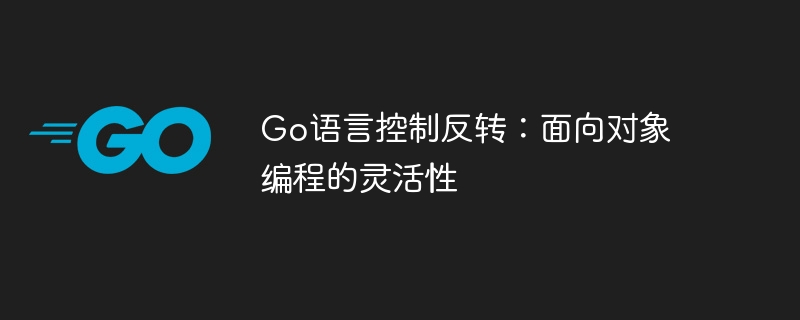
Inversion of control in the Go language provides flexibility for object-oriented programming by separating object creation and dependency injection: IoC basic principle: external containers or frameworks manage object creation and injection, and objects no longer directly instantiate other objects. . Dependency injection: Dependencies are passed to objects as parameters, making the object independent of its dependencies for easy testing and reuse. IoC container: used to manage object creation and injection. The Go language has many ready-made containers to choose from, such as wire and go-wire. Advantages: Enhance testability, improve maintainability, provide flexibility, loosely couple dependencies between objects.

Go Language Inversion of Control: The Flexibility of Object-Oriented Programming
Introduction
Inversion of Control (IoC) is a design pattern that separates object creation and dependency injection. With IoC, we can control the relationships between objects, thereby enhancing the testability and maintainability of our code. The Go language provides strong IoC support, making it ideal for object-oriented programming.
Basic Principle
The basic principle of IoC is that objects should not directly instantiate other objects, but an external container or framework will manage the creation and injection of objects. .
Dependency injection
Dependency injection is the core principle of IoC. It refers to the process of passing an object's dependencies as constructor or method parameters. This way we can make an object independent of its dependencies, making it easier to test and reuse.
Container
IoC container is a component used to manage object creation and injection. It is responsible for instantiating objects and injecting their dependencies into them. There are many ready-made IoC containers in the Go language to choose from, such as [wire](https://pkg.go.dev/github.com/google/wire) and [go-wire](https://github.com /kevinburke/go-wire).
Practical Case
Consider the following sample code, which shows how to use wire to implement IoC in the Go language:
// subject.go
package main
import "errors"
type User struct {
Name string
}
type UserService struct {
// UserService depends on the User type.
User User
}
func NewUserService(user User) UserService {
return UserService{
User: user,
}
}
func (us UserService) Greet() (string, error) {
if us.User.Name == "" {
return "", errors.New("user name is empty")
}
return "Hello, " + us.User.Name, nil
}
func main() {
user := User{Name: "John"}
container, err := wire.NewSet(
wire.Value(user),
wire.Struct(new(UserService), "*"),
)
if err != nil {
panic(err)
}
var us UserService
if err := container.Inject(&us); err != nil {
panic(err)
}
greeting, err := us.Greet()
if err != nil {
panic(err)
}
fmt.Println(greeting) // Output: Hello, John
}Advantages
The main advantages of IoC in the Go language include:
Conclusion
IoC is a valuable tool for object-oriented programming in Go language, which provides flexibility, testability, maintainability and loose coupling . By understanding its fundamentals and using appropriate IoC containers, Go developers can build more robust, maintainable, and testable code.
The above is the detailed content of Inversion of control in Go: the flexibility of object-oriented programming. For more information, please follow other related articles on the PHP Chinese website!
 Usage of Type keyword in Go
Usage of Type keyword in Go
 How to implement linked list in go
How to implement linked list in go
 What are the Go language programming software?
What are the Go language programming software?
 How to learn go language from 0 basics
How to learn go language from 0 basics
 What are the methods to implement operator overloading in Go language?
What are the methods to implement operator overloading in Go language?
 What are the operators in Go language?
What are the operators in Go language?
 The most prominent features of computer networks
The most prominent features of computer networks
 How to open img file
How to open img file




